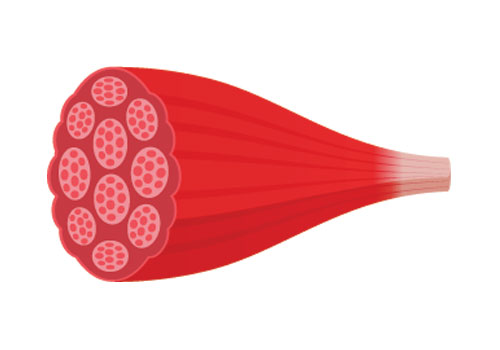- Empty cart.
- Continue Shopping
Understanding the Different Types of Muscle Fibers

When it comes to building strength, endurance, and muscle, not all fibers are created equal. Understanding the different types of muscle fibers can be a game-changer in optimizing your workout routine. We aim to shed light on the various kinds of muscle fibers, their functions, and how you can tailor your exercise regimen to make the most of each type.
The Basic Anatomy of Muscle Fibers
Before diving into the types, let’s first understand what muscle fibers are. Muscle fibers are essentially the building blocks of your muscles. They are long, slender cells that contract to produce movement. Each muscle in your body contains a mix of different fiber types, which contribute to the muscle’s overall function.
Slow-Twitch Fibers (Type I)
Slow-twitch fibers, also known as Type I fibers, are built for endurance. They are the marathon runners of the muscle world. These fibers can sustain force over an extended period but lack the power for quick bursts of speed or strength. They are rich in mitochondria, the energy-producing units in cells, which allows them to resist fatigue.
Characteristics:
- High endurance
- Slow to fatigue
- Low power output
Fast-Twitch Fibers (Type II)
Fast-twitch fibers, or Type II fibers, are the sprinters in the muscle community. They are designed for quick, powerful bursts of activity but tire out quickly. Within this category, there are two subtypes: Type IIa and Type IIx.
Type IIa
These fibers are a hybrid, offering a balance between endurance and power. They are faster and more powerful than Type I but have more endurance than Type IIx.
Type IIx
These are the most powerful and fastest fibers but are also the quickest to fatigue.
Characteristics:
- High power output
- Quick to fatigue
- Low endurance
How to Train Different Muscle Fibers
Knowing the types of muscle fibers and their characteristics can help you tailor your workouts for specific goals.
For Endurance
If you’re training for an endurance event like a marathon, you’ll want to focus on exercises that target your slow-twitch fibers. Long, steady-state cardio sessions are effective for this.
For Strength and Power
If your goal is to build strength or power, then exercises like weightlifting, sprinting, or plyometrics can help you target your fast-twitch fibers.
For a Balanced Approach
For those looking for a well-rounded fitness routine, incorporating a mix of both endurance and strength exercises can provide a balanced approach.
The Role of Genetics
It’s worth noting that genetics play a significant role in the distribution of muscle fiber types in your body. Some people naturally have more of one type than the other, which can make them more inclined toward either endurance or power activities.
Finally, understanding the different types of muscle fibers is more than just science; it’s a way to optimize your workouts for maximum results. Whether you’re looking to build endurance, strength, or a combination of both, knowing how to target specific muscle fibers can give you an edge in achieving your fitness goals. So the next time you hit the gym, remember that not all muscle fibers are created equal, and train accordingly.








